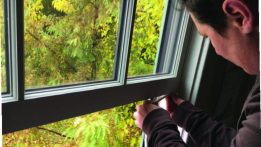 Florida State University’s President’s House has a rich history that dates to 1895, making the home a local legacy. Originally set on the corner of Duval and St. Augustine Street, a two-story home with a gracious wrap-around porch stood proudly. In the 1800s, this house belonged to William M. McIntosh, a hardworking resident of the Tallahassee area. He served as the Chief Clerk of the Florida Comptroller’s office for nearly 50 years. After his passing, the home was eventually relocated in 1948 to its current address on West Tennessee Street. The home was to become the place of residence for Florida State University’s fifth president, Doak Campbell. Campbell’s immediate family members lived with him in the home. In his book titled A University in Transition, Campbell stated the importance of the McIntosh home. He did not see the space solely as a living area; rather, the Campbells intended for the dwelling to also be a place where the university could celebrate major milestones and achievements together. They felt it necessary to share the home with the collegiate community through acts of true southern hospitality. This tradition continued as later presidents of the university also moved into the space with their families during their time in office. Thus began one of FSU’s major architectural legacies.
Florida State University’s President’s House has a rich history that dates to 1895, making the home a local legacy. Originally set on the corner of Duval and St. Augustine Street, a two-story home with a gracious wrap-around porch stood proudly. In the 1800s, this house belonged to William M. McIntosh, a hardworking resident of the Tallahassee area. He served as the Chief Clerk of the Florida Comptroller’s office for nearly 50 years. After his passing, the home was eventually relocated in 1948 to its current address on West Tennessee Street. The home was to become the place of residence for Florida State University’s fifth president, Doak Campbell. Campbell’s immediate family members lived with him in the home. In his book titled A University in Transition, Campbell stated the importance of the McIntosh home. He did not see the space solely as a living area; rather, the Campbells intended for the dwelling to also be a place where the university could celebrate major milestones and achievements together. They felt it necessary to share the home with the collegiate community through acts of true southern hospitality. This tradition continued as later presidents of the university also moved into the space with their families during their time in office. Thus began one of FSU’s major architectural legacies.
In 2003, Florida State University elected a new president into office. An alumnus of the university, Thomas Kent Wetherell, famously known as his nickname T.K., garnered a reputation as one of the most powerful politicians in Florida. Wetherell and his wife, Virginia Wetherell (also known as Ginger), are noted as an extremely influential dynamic in higher education legacies. Under Wetherell’s presidency, Florida State University soared in terms of admission rates, money available for student research, and additional construction renovations happening on and off campus. Most notable of these projects is the restoration of the original McIntosh house. The goal for this antique home was to refurbish the place into what we now know as today’s Welcome Center for the FSU Alumni Association. This was largely due to one of T.K. Wetherell’s main priorities as a leader. He and his wife wanted to take on a build project for a brand new President’s House to continue honoring FSU’s legacies in a modern way. Construction on the premier home started in 2005 with T.K. acting as project manager over the whole two-year span of building and Virginia (Ginger) being the one who made the choices regarding the design and decoration aspects of this 13,068 square-foot architectural feat. “I wanted this house to feel like it has always been here, to feel like it was here before the university started, and the university grew up around it,” Ginger said in an interview with Tallahassee Magazine.
Since the home was intended to be both a living space and a campus facility, it was important that site construction be highly intentional to accommodate the private residents of the home and any welcomed visitors. Greek revival architecture was a very popular design style in the United States in the late 18th and early 19th centuries. To sustain authenticity, the Wetherells decided to honor this style in their construction of the new home. Some features of Greek revival structures include symmetry, columns or pilasters (square columns), covered entrance porches, and decorative top ends known as capitals on the columns. The President’s House showcases fluted Greek Doric columns at the formal front entry with a more relaxed porch design on the rear of the home. These architectural differences visually suggest the many adaptations the home has undergone over generations. Other noticeable aspects outside of the home include a dedicated driveway intentionally created for the president and anyone who lived there so that the residents would be able to enter through a private entrance, giving them a homier feeling. To mitigate the flow of people, an additional entryway was created to lead guests toward the lower level of the home. This area is intended for visitors to attend university gatherings and events. Some of these guests include students, faculty, alumni, government officials, national and international scholars, corporate representatives, many other powerful leaders, and of course, friends and family.
 Once you make your way through the lower-level entry, you are greeted with just some of the many dazzling features that Ginger picked out to amaze guests when they are invited inside. These may include features like the early 18th-century French chandeliers that adorn the dining rooms, floor to ceiling height windows that lead to the screened terrace, or Turkish rugs on the floors brought back from a university-sponsored trip to the Greek Isles. The public level of the home is set up to allow guests to enjoy numerous activities with leisure. You may converse in the event room, play games in the billiards room, grab a drink at the bar, or get something wonderful to eat provided by their staff in a fully functioning kitchen.
Once you make your way through the lower-level entry, you are greeted with just some of the many dazzling features that Ginger picked out to amaze guests when they are invited inside. These may include features like the early 18th-century French chandeliers that adorn the dining rooms, floor to ceiling height windows that lead to the screened terrace, or Turkish rugs on the floors brought back from a university-sponsored trip to the Greek Isles. The public level of the home is set up to allow guests to enjoy numerous activities with leisure. You may converse in the event room, play games in the billiards room, grab a drink at the bar, or get something wonderful to eat provided by their staff in a fully functioning kitchen.
Whether you find yourself as a guest of the President’s House or simply pass by it while driving down West Tennessee Street, you have the opportunity to take in the legacy the Wetherells built. It stands as a notable landmark of time, accomplishment, and history. Understanding the deep sentiments and historical legacy of the building allows us to garner a greater appreciation for it and all of those who came together to make its existence possible. ![]()
Brooke Dixon
Home & Yard Magazine




